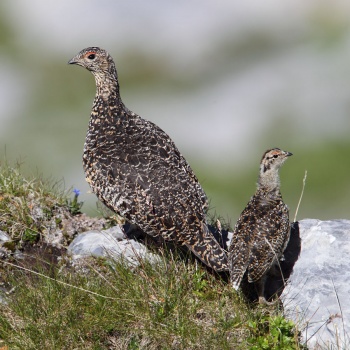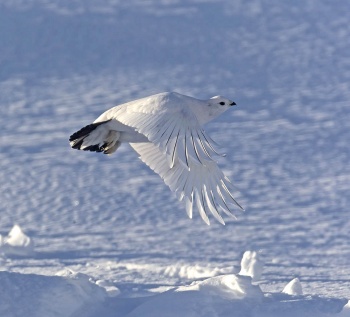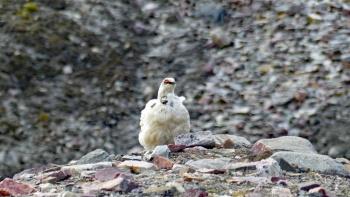- Lagopus muta
Identification
33–40 cm (13-15¾ in)
- Feathered feet, bare red skin over the eye
Breeding male
- Greyish upperparts
- White wings and underparts
Winter male
- Almost completely white
- Black tail
Female is browner than the male
Distribution
Arctic and subarctic Eurasia and North America including Greenland.
Taxonomy
Subspecies
This is a polytypic species consisting of consisting of about 29 subspecies[1]:
- L. m. hyperborea: Svalbard, Franz Josef Land and Bear Island
- L. m. muta: Norway, northern Sweden, northern Finland and Kola Peninsula
- L. m. millaisi: Scotland
- L. m. pyrenaica: Pyrénées
- L. m. helvetica: Alps (Savoie to central Austria)
- L. m. komensis: Northern Ural Mountains
- L. m. pleskei: Northern Siberia (Taymyr Peninsula to Chukotsk Peninsula)
- L. m. macrorhyncha: Tarbagatay Mountains (Russia)
- L. m. ssp.: Undescribed race from Pamir Alaï Mountains (Tajikistan)
- L. m. nadezdae: Mountains of southern Siberia and Mongolia
- L. m. transbaicalica: South-eastern Siberia (Lake Baikal to Sea of Okhotsk)
- L. m. kraschennikovi: Kamchatka Peninsula
- L. m. ridgwayi: Komandorskiye Islands
- L. m. kurilensis: Kuril Islands
- L. m. japonica: Honshu Island (Japan)
- L. m. evermanni: Attu Island (Aleutian Islands)
- L. m. townsendi: Aleutian Islands (Kiska and Little Kiska)
- L. m. gabrielsoni: Aleutian Islands (Amchitka, Little Sitkin and Rats)
- L. m. sanfordi: Aleutian Islands (Tanaga and Kanaga)
- L. m. chamberlaini: Adak Island (Aleutian Islands)
- L. m. atkhensis: Atka Island (Aleutian Islands)
- L. m. yunaskensis: Yunaska Island (Aleutian Islands)
- L. m. nelsoni: Aleutian Islands (Unimak, Unalaska and Amaknak)
- L. m. dixoni: Coasts and mountains of Glacier Bay to north-western British Columbia
- L. m. kelloggae: Alaska and northern Yukon
- L. m. rupestris: Tundra of northern North America
- L. m. saturata: North-western Greenland
- L. m. macruros: Eastern Greenland
- L. m. reinhardi: South-western Greenland
- L. m. welchi: Newfoundland
- L. m. islandorum: Iceland
Habitat
Sparsely vegetated rocky tundra and mountainous slopes. In very severe weather, they may move down to the edges of forests.
Behaviour
Diet
Their diet consists of plant shoots, leaves and buds. Also berries and insects.
References
- Clements, J. F., T. S. Schulenberg, M. J. Iliff, D. Roberson, T. A. Fredericks, B. L. Sullivan, and C. L. Wood. 2017. The eBird/Clements checklist of birds of the world: v2017, with updates to August 2017. Downloaded from http://www.birds.cornell.edu/clementschecklist/download/
- Handbook of the Birds of the World Alive (retrieved January 2016)
- RSPB
- Wikipedia
Recommended Citation
- BirdForum Opus contributors. (2024) Rock Ptarmigan. In: BirdForum, the forum for wild birds and birding. Retrieved 19 April 2024 from https://www.birdforum.net/opus/Rock_Ptarmigan
External Links
GSearch checked for 2020 platform.1







